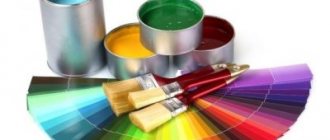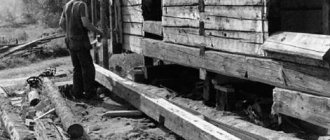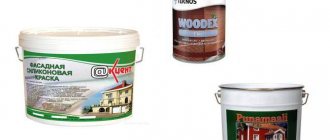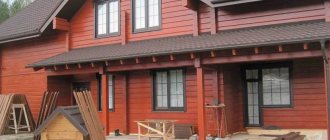I am glad to welcome my reader again!
Today we’ll talk about how to paint a log house? In general, I would say this: paint it a different color or preserve the original texture of the log house. Even if in some places with areas darkened by time and other external natural defects, but preserved in an authentic form. The topic is: how to paint the outside of a bathhouse frame and be satisfied with your work for many years?
Just in case, be mentally prepared for the fact that after painting you will not see exactly what you saw on the salesperson’s display board in the store. Somewhere the shade is not the same, roughness is possible, and the paint consumption, as a rule, exceeds what was promised. Let me reassure newcomers - this is a common reaction.
They paint ideally only in television advertisements... remember, they will run a brush or roller over the wall and immediately get a beautiful solid color. But this is the merit of the cameramen, not the paint manufacturers or plasterers. And in life, there are always “pleasant” nuances.
Why do you need to paint the outside of a wooden bathhouse?
- For protection against weather conditions. Sun, precipitation, wind - all this does not improve the tree;
- To protect against temperature changes emanating from inside the bath, which also affect the durability of the material;
- For protection from various biological lesions;
- For a more aesthetic appearance.
Points 1, 2 and 3 serve to extend the life of the wood base, and this is the main thing. And point 4, for some, is a controversial point. Someone will say, how can the color of paint be better than the texture of natural wood...
Painting of the log house must be preceded by the application of a primer coating, an antiseptic and a fire retardant compound (pyrine retardant). It is important. The antiseptic will create protection against wood insects, fungal mold, rotting and other things, antipyrine, and increase the fire resistance of the structure. Both substances can be chosen either in the form of a colorless substance or an enriched color.
By the way, there are some paints that contain antiseptic and water-repellent impregnations. According to many experts (who always play it safe), it is better to perform priming as a separate process.
And after sanding (when the wood loses its roughened layer and becomes easily accessible to all kinds of biological damage), this must be done immediately.
Before treating with protective substances, you need to check the quality of the log caulk and, if necessary, bring it into compliance. It is worth considering that the ends of the log house absorb moisture more strongly and therefore it is recommended to apply two or three additional layers to them.
Briefly about lining coating
When thinking about how to process wood in a bathhouse, you first need to prepare the necessary tools and buy additional materials:
- Solvent;
- Stirring brush;
- Roller;
- It is recommended to purchase a spray gun, but you can apply the varnish in other ways;
- Sponge;
- Paint tray;
- Protective equipment (respirator, goggles, gloves and overalls).
It is important to remember that the impregnation of the sheathing must be carried out strictly before its installation. It is also necessary to process the sheathing on which the lining will be attached.
After the impregnation has dried, you can sheathe the room.
Having completed the installation work, it is necessary to process the wood again
It is important to note that it is important to carry out such treatment approximately once every 2 years, because the coating on the wood takes the “blow” and wears out, keeping the wood in the bath
How to prime the log house?
Of “our” “priming” products on the market, I would like to highlight Neomid. What distinguishes it is good quality and reasonable price. The line of products for wood allows you to “close” almost all needs: Fire protection, bio-antiseptic, moisture protection, etc. Reviews for the brand are good.
Another Russian manufacturer, the Senezh company, which produces a rich line of products. The assortment includes several protective compounds for different purposes (I mean, intended specifically for outdoor woodwork). In addition to primers, there are varnishes and paints on an organic and synthetic basis (acrylate, oil, etc.).
Principles of coloring
In order for the decorative coating to last longer, you need to take into account the specifics of the work and know how to prepare the surface.
Preparation
Before you start applying paint to the walls, floor, ceiling in the bathhouse or outside, you need to complete the following preparations:
- Caulk the timber walls, cover the cracks with a special wood putty. The walls must consist of several layers - vapor barrier, wooden frame, insulation, foil film, slatted frame, finishing material. Paint is applied on top.
- You need to remove uneven surfaces from brick surfaces and knock down old mortar. Depressions and cracks should be covered with plaster.
After leveling the surfaces, you can begin decorative finishing.
Wood putty (Photo: Instagram / color_174)
Tools
To perform the work you need to prepare:
- Tassels. Can be with natural or artificial bristles.
- Rollers. There are fur, velor, polyamide, foam rubber.
- Sharp knife, scissors.
- Dry rags, solvent.
- Containers for paint.
- Thick polyethylene film.
- Plastic stick.
- Masking tape.
If you need to paint the outside of the building, it is recommended to use a spray gun. With its help you can quickly paint large surfaces.
Features of the work
You need to start painting the walls, ceiling, floor by cleaning the room and preparing consumables. All items that cannot be painted must be covered with plastic wrap. Skirting boards and trim can be sealed with masking tape. The composition is applied in one layer. If it is not enough, you can apply a second one. Metal surfaces must be pre-primed.
Masking tape (Photo: Instagram / detailingmarket)
How to paint a log house?
The lower crowns are treated with waste oil.
Let's divide the materials into two types: folk and modern. First, I will give a few folk recipes. What if someone wants...
Waste machine or transformer oil
Yes, the smell is not very good, but it will disappear after a while, but the impregnation will remain and will create a waterproof layer. Although dust sticks to it “freshly”. Apply the oil with a rough brush and rub in thoroughly.
Turpentine and wax
Mix in equal proportions. In addition to protecting against moisture, this composition provides good protection against wood insects and gives the walls of the log house a certain gloss of “well-kept antiquity.” Particularly suitable for painting baths “in years”.
Oak bark decoction
A nice darkened background, however, the wood pattern is clearly visible through it. An old and forgotten method.
It is better not to make coloring compositions from onion broth (these are not eggs for Easter). Yes, they give the logs a pleasant shade, but as an “undesirable bonus” they have a smell that attracts insects.
My opinion is that you shouldn’t get carried away with environmental products. In a number of ways, it is no longer easy for them to compete with the products of the chemical industry. But if you are a principled supporter of natural raw materials, then, without a doubt, go ahead!
Tools and technologies
The main tools for painting with almost any composition have been and will be the following:
- brush;
- roller;
- spray gun.
In addition, you can buy some types of paints in aerosol cans, but their cost is significantly higher than their counterpart in a can.
Brushes come in different types: from natural bristles, artificial bristles and mixed bristles. All of them are used for applying paints to one or another prepared surface. It is better to apply water-soluble paints using artificial bristle brushes; they do not retain water.
The brush is wetted by a third in the paint, on both sides. After that, the paint is applied to the cleaned surface with short (!) strokes. The direction of the strokes should always be along the grain of the wood.
Rollers are also different:
- foam;
- velor;
- fur;
- polyamide.
With the exception of foam rubber, all can be used for applying paints on any basis; foam rubber is suitable for water-soluble paints and nothing more.
The spray gun is convenient, but not as accessible as brushes and rollers. You will find varieties for water-soluble and alkyd paints, with an upper or lower location of the tank for the spray composition.
The paint is supplied under air pressure from the compressor, so you must first adjust its viscosity (using a solvent), and then adjust the air supply. This is often done experimentally. First, the maximum spraying is set, the flow of paint is checked - if it falls in the smallest drops, everything is fine, otherwise a solvent is added in an amount of 5% of the volume. Check again.
The air supply is calibrated by the type of drips under the stained spot: if they are at the edges, then the air flow should be reduced, if under the middle of the spot, then increase it.
The paint should be applied evenly, perpendicular to the surface, from a distance of 15 to 25 cm. Overlap the layers, but make sure that the width of the overlap is not more than half of the already painted area.
Now I turn to modern materials
I will talk about those that are intended specifically for wooden buildings.
Belinka
The Belinka brand has long proven itself well. The range includes not only paints, but also varnishes, various impregnations, and glazing compounds. The range of shades of varnish and paint is very colorful, allowing you to preserve the texture of the wood, emphasizing it with a decorative background. Belinka polyacrylate paints create a film on the surface of wood that, on the one hand, has water-repellent properties and, on the other, is vapor-permeable.
Tex
Professionals speak positively about the Russian manufacturer Tex. In addition to paint, the company has several types of antiseptics, including ground and glaze, drying oils, fire retardant impregnations and wax-based compounds.
A separate point that is often not paid due attention: the protection of metal parts. Heads of nails and screws, hinges, corners, etc. are susceptible to corrosion. For protection, special compounds are used. The same Neomid has them.
Tikkurila
If finances allow, contact the Tikkurila brand, respected in Russia. The paints of this Finnish manufacturer have been tested in the harsh conditions of the northern climate. They contain components containing various additives that prevent the formation of rot, moisture absorption, and protect against ultraviolet radiation.
You can choose from acrylate paint called Pica-Techo, oil Techo, polyacrylate, Ultra-Classic. This brand, in addition to its relatively high price, has another drawback - names that are difficult to remember. Here they are.
And of course, the Finnish company has all EU certificates confirming environmental friendliness.
By the way, if the coating of the log house was done with oil paint, then the next coating (for example, after 3-5 years) should also be done with oil paint.
In general, recommendations for painting a log bathhouse boil down to what needs to be taken into account:
- Firstly: the better (that is, more famous) the manufacturer, the better and more durable its primer and topcoats;
- Secondly: use special-purpose compounds, in our case, intended for external wooden walls. If you find among well-known manufacturers special paints for facades made of rounded logs, it will be even better, but, unfortunately, I don’t know such paints.
Saikos
Finally, let’s touch on the German manufacturer SAICOS. The catchphrase - “True German quality” is very relevant to this day. The main feature of this product is that the base is only natural oils and waxes. The conclusions here are simple: such wood impregnation will preserve your structure for many, many years. In a word - I recommend it. I think that professionals will understand me...
What characteristics of painting materials should you pay attention to?
- Possibility to use outdoors.
- Can be used indoors (environmentally safe).
- How it holds high temperatures (relevant for steam rooms).
- Does it provide protection against fire and biological damage?
- What materials does it combine with?
- How many layers should be applied?
- How long does it take to renew the coating?
- What kind of materials is the product designed to process (permissible moisture content of the lumber, is there any damage or is our surface completely healthy...).
- Does it form a film (glossy, matte surface...).
- Does the level of vapor permeability of wood change?
- Is there a coloring effect, can it be tinted?
- How long does it take for the layer to dry, at what temperatures can it be applied.
- What application methods are acceptable?
Imitation timber in the form of profiled or planed boards is an excellent material that is suitable for finishing houses both outside and inside. However, after installation, the material needs protective impregnation, created on the basis of special compounds with membrane properties.
This coating will protect the wood from the adverse effects of moisture, microorganisms and various harmful insects that destroy the wood. For this purpose, imitation timber is painted. In addition, this procedure is done in order to transform the appearance of a room or home.
Wood bleaches
If black or blue spots begin to be visible on the walls of the bathhouse, this most likely indicates the appearance of mold or mildew. To return the timber to its original appearance and at the same time get rid of biological pests, special chlorine-based bleaches are made. If the wooden material is not severely affected by fungi and mold, then you can use the composition Neomid 500 or Prosept 50. If the condition of the timber is neglected, then everything can be corrected with the more powerful League BioShield. All these domestic whitening compositions are effective and act for a short period of time.
The process of painting a room
The process of painting the inside of a bathhouse begins with thoroughly sanding all surfaces to be treated - these are walls, floors and furniture, if necessary. After this stage, all construction dust or shavings must be removed from the room, as they will interfere with the quality of the painting process. You can wipe the surfaces with a cloth; it is better to leave it dry or vacuum it.
Paint can be applied with a roller or brush
Before applying colored paint, it is best to treat the wood with compounds that will protect against fire and mold. After they dry, you can decorate the room with the chosen color of the dye. Work is best carried out in a well-ventilated area with a constant air temperature.
Related Article: How to Use Chain Fencing
Protective treatment of critical structures
Application of protective compounds
Structural elements of the house that must be treated with special care include:
- Mortgage crown,
- Corner ends of the log walls,
- Attic structures,
- Floor joists on the first floor.
These elements are most susceptible to external negative factors and are most often affected by biopests; it is necessary to choose the right ways to protect them.
The best way to process the embedded crown
The frame is the lowest crown of the log house, the most vulnerable to putrefactive fungus, this is caused by its getting wet from moisture accumulating on the edge of the foundation. Conventional protective agents are ineffective in this case; experienced professionals recommend using “folk” remedies that provide more effective antiseptic protection. Among such means:
- A solution of copper or iron sulfate, the timber is placed in a bath with a 1.5 percent solution of vitriol for 2-3 hours, the composition is deeply absorbed into the wood, the timber is ready for use after drying for 3-4 hours,
- Finnish composition, which is prepared according to the following recipe: a homogeneous paste made from 750-800 g of any flour is poured with 10 liters of warm water, alternately adding 1.5 kg of copper sulfate, 400 g of salt, 1.5 kg of slaked lime and stirring thoroughly. The timber is treated on all sides in two layers, the composition is applied with a brush or roller, complete drying time is 12 hours.
Corner end protection
The corner ends of the log house absorb 10 times more moisture than the walls; the process of intense wetting and drying causes the appearance of deep cracks, which create a favorable environment for the development of putrefactive fungus. To reduce this process, the ends are “riveted” with a rubber or wooden mallet; deliberate destruction of the wood structure prevents the formation of deep cracks. After this operation, the ends are impregnated from the outside with deep-penetrating compounds such as “Aquatex”. When finishing the ends, a protective acrylic coating “TEKNOL JRM” (Finland) or a water-dispersion agent “Remmers SW-910” (Germany) is used; the compositions form a durable protective film resistant to low temperatures.
Treatment of attic structures
Fire statistics show: fires in wooden houses and bathhouses begin in the attic; chimneys and ventilation hoods are located in this space. From the outside, atmospheric moisture does not penetrate into this space; in summer the air temperature rises above 40 degrees, the racks and rafters are always dry, which increases the likelihood of fire. Rafters, roofing sheathing and counter beams are additionally impregnated with fire retardants, including: non-flammable paints and varnishes, fire-resistant pastes and mastics. A popular fire retardant is biopyrene “Pirilax” (Russia), which has antiseptic properties.
Protection of joists under the floor on the first floor of the house
Logs under the floor are classified as hard-to-reach structures, the periodic processing of which is difficult. The joists on the ground floor of the house are protected from atmospheric moisture, while at the same time, excess moisture accumulates in the basement due to soil evaporation. Such conditions are favorable for the development of harmful insects, rodents and fungi. To reduce air humidity in the underground space, natural ventilation is installed.
Floor joists are treated in various ways; one of the effective methods is burning the surface with a blowtorch. Wood capillaries are destroyed by fire, the process of natural moisture absorption is disrupted, and the ash layer is an antiseptic. After such treatment, the logs are impregnated with finishing compounds, including bitumen impregnations and mastics.
Where can I buy these quality products?
Photo: the most popular antiseptic and decorative impregnations of the Neomid brand.
You can buy high-quality wood preservatives for processing wooden log houses, high-quality sealants for wood, from our company, which is the official dealer of effective impregnations Neomid and Prosept.
Call, check the availability and cost of wood protection products for wooden log and timber frame houses.
Useful tips
- For the exterior walls of the log house, it is advisable to choose dark colors - this will help protect it from exposure to sunlight. On the street side, it is not at all necessary to use water-based paint; you can also use it containing alkyd resins (based on a chemical solvent).
- It is better not to treat the steam room with glazes and paints, because this room has the highest temperature and humidity. For this purpose, you can use water-resistant, heat-resistant acrylic varnishes based on water. Their use will protect and emphasize the structure of the wood, avoid a strong odor, and make it possible to touch the walls without the risk of getting burned.
- In the washing room, it should be taken into account that here all surfaces often come into contact with hot water and steam. This makes them vulnerable to rot and insect pests. Before painting, this room must be treated as thoroughly as possible with an antiseptic.
- After impregnation, it is better to cover the remaining rooms inside the log house with varnishes or paints based on water, and not on a chemical basis.
- When choosing a protective impregnation, it is better to give preference to one that contains insect repellents.
- When painting outside walls, remember that the ends absorb paint more strongly. They can and should be applied 1-2 more layers.
- Chemical compounds must be applied only to previously cleaned and dry surfaces.
- Before you start painting the floor, it should be treated in several layers with moisture-proof and antibacterial impregnations.
These simple recommendations will help you easily cope with cosmetic repairs and significantly extend the life of the structure. If you take care of your bathhouse in a timely manner and competently make minor repairs, it will please the owners for a long time.
Work order
As it has already become clear, the main goal when choosing a product for painting the outside of a log house is to protect it from various types of influence. But to ensure 100% protection, it is not enough to buy a high-quality coating; it is also important to carry out the painting work correctly. Here are some valuable tips that should help.
It's better to paint it yourself. This will not only save the family budget, but will also provide benefits in the quality of painting. It is important for the construction team to deliver a beautiful object visually, so they will not worry about the thorough processing of each element. Namely, small unpainted places can later cause the appearance of rot, fungus and other troubles.
Proper preparation of a log house for painting. Before painting, it is worth preparing the log house for this stage of finishing work. First, the surface of the wood is cleaned of dust and dirt. It is best to wash the wood and then let it dry. It wouldn't hurt to do some sanding. After this, several layers are applied to the surface of the wood:
It is best to paint the ends of the logs with lime or a similar composition. This is worth doing so that steam can move along the log along the fibers, as when a tree grows. This is much better than across.
There is no need to leave gaps when painting. To do this, add a little colored tint to the colorless antiseptic. After applying it, let it dry thoroughly. This way you can avoid the presence of even the smallest unpainted areas, which can subsequently lead to quite serious problems.
In conclusion, it should be advised that when choosing, you should focus on the most beautiful options, because a bathhouse should please not only the soul, but the eye.
Source
Brand overview
When choosing varnishes, enamels and paints for painting baths and saunas, you should give preference to specialized lines, since the creators of such products take into account all the technical features and characteristics of wet rooms. The Finnish company Tikkurila is considered the absolute market leader in this segment. Among the most popular compositions from this manufacturer are the following.
- Supi Saunasuoja is a high-quality impregnation for interior coatings based on an aqueous solution with acrylic. Can be used in rooms where the temperature exceeds 100 degrees. Available in a condition suitable for tinting.
- Supi Laudesuoja – oil enamel, used for painting shelves in saunas.
- Supi Saunavaha - this varnish is considered a universal product intended for all types of bath surfaces.
Users note that imported formulations are very effective, especially when it comes to Finnish manufacturers. They have only one drawback - the high price. That is why some bathhouse owners prefer Russian manufacturers who offer cheaper lines. Here are a few brands that are in demand when painting bathhouses.
- “Senezh Sauna” is an acrylate antiseptic used to protect wood lining in bathhouses. Includes a fungicidal component and has no chemical odor.
- Neomid 200 is an effective coloring agent that includes antiseptic components. The composition is in demand when processing shelves, benches and other wood coverings in saunas and baths.
- Neomid Sauna is a translucent acrylic-based varnish, used for impregnation of wooden lining in steam rooms and other rooms with high humidity.
Compositions
there is no need to process it inside at all
A steam room is a place where elevated temperatures make various substances more volatile. These are the smells of herbs, and resins in wood, and phenols in mineral wool... In general, if you smell the smell, it means something has warmed up and is “phoning.” It’s bad when paint or varnish, or PVC, or mineral wool, or sulfides in stones begin to “sink.” Therefore, they try not to put plastic in the steam room; for insulation they use only those heat insulators that do not release binding substances when heated (if mineral wool, then with a mark on the packaging “for saunas and baths”)...
But the modern paint and varnish industry has already taken a technological step towards greater humanity and environmental friendliness. Now there are water-based varnishes and paints that practically do not smell when applied, and after drying they form a fairly durable polymer that does not smell of anything at all.
Therefore, the Finns, knowing perfectly well what temperature conditions they have in their steam rooms, make and sell compositions that have been tested and are considered safe. These are water-based acrylic coatings. Or they are impregnations made from completely safe oils - linseed, paraffin...
However, don’t even let the paint harm your health with its smell, it reacts quite poorly to moisture, tends to peel off, hang in rags... Therefore, if you paint the steam room in a bathhouse with anything, then only with special compounds that are suitable for bathrooms (also written on the packaging ). Such coatings are waterproof.
So, coatings such as varnish are not so much for beauty, but for protection - from cracks and deformations, from mold.
You can protect the floor by using waterproof yacht varnish. Even though it contains polyurethane or urethane. The thing is that the temperature on the floor in the sauna is low - the Finns are required to have a 5-10 cm gap under the door to the steam room.
In a Russian steam room, if you don’t make special heated floors, it’s also not that high, it’s unlikely to be higher than 30 degrees. Therefore, yacht varnish will not hurt here either.
Waterproof, highly abrasion resistant varnish will make the floor more durable. Just don’t allow a problem like the one in the video below.
The walls can also be varnished, but this time it is safer.
Such varnishes are available from different manufacturers - both Russian and foreign. Teknos, Belinka, Tikkurila, Dulux have them, as well as ours - Neomid, Senezha, Rogneda, etc. If there is a certificate, it means the product is good.
Oils
When they talk about “oil for a steam room in a bath,” they mean impregnation for wood, but not drying oil. Compositions have long been developed that do not smell like drying oil. In particular, there is no smell from paraffin oil.
Treatment of the bathhouse inside the steam room with oils is usually limited to covering the shelves with them. This is done because it is the safest way for humans to protect the tree.
On sale you can find both liquid oil compositions and more solid varieties containing, in addition to oil, also beeswax. The latter are even better, considering that wood has been waxed for a long time, and not only for a beautiful shine, but also to increase its service life and protect it from all kinds of pests.
Conclusion
In the video presented in this article you will find additional information on this topic. Also, based on the text presented above, we can come to the conclusion that there are several effective means for external treatment of log walls (see also the article How to apply impregnation for a bathhouse). They have different degrees of protection and are used in accordance with the technical conditions and personal preferences of the master.
Did you like the article? Subscribe to our Yandex.Zen channel











